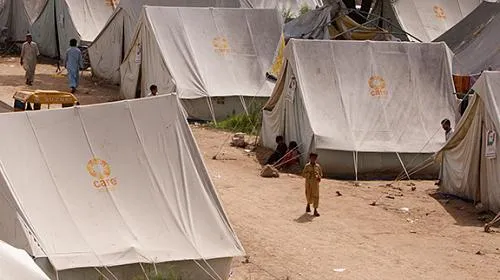Oct. 7, 2007 – 46 million or more people have been affected by torrential rains and extreme monsoon weather across India, Bangladesh, Nepal, and Pakistan.
The October 1, 2007 press release – jointly issued by the United Nations, CARE and other leading humanitarian organizations – warns “a more forceful international response is necessary to prevent an even greater catastrophe that will have debilitating social consequences for the affected populations.”
Flash floods, landslides and rivers that burst their banks killed thousands, and have stranded many thousands more. Millions have been left homeless. In all, 48 million or more people have been affected by the floods, and rains have yet to cease.
Even as flood waters recede in some areas, survivors are facing a humanitarian crisis of major proportions. They have little or no food. They barely have shelter. They have lost all means of earning their livelihood, and many lack access to basic sanitation facilities. Diseases such as cholera and dysentery are a constant threat.
Many of these people are in areas where CARE has been working hard for years on development programs to end poverty. They risk falling back into even deeper poverty, unless CARE and the international community act now. CARE mounted an immediate response and is committed to helping with longer-term recovery. Although international awareness of the full dimensions of the crisis has been slow to develop, it is clear to CARE staff on the ground that this is a humanitarian disaster of enormous proportions.
Flooding devastates homes and crop lands in India
India has been hit by the worst floods in more than a decade, tens of millions of people affected. The situation – particularly in Bihar, West Bengal, and Assam – continues to be serious with fluctuating monsoon activity. At least 1 million houses have been destroyed or partially damaged, and many villages remain so waterlogged that people cannot return. Almost 5 million hectares of crop lands are submerged in flood waters, and livestock has been decimated. CARE has been providing shelter, food, water purification tablets, emergency sanitary facilities and medical assistance. Recovery programs are planned for 80 villages of Bihar, Uttar Pradesh, West Bengal and Orissa.
Agriculture recovery efforts in Bangladesh
In Bangladesh, extended and early recovery assistance is still greatly needed. For the poorest amongst the flood-affected population, needs exceed resources. While, in some areas, the flooding is receding from homes and roads, water still stands on fields. CARE has been helping with evacuation and relief operations, food distribution, emergency shelter, medical support, water purification tablets, and non-food items like clothes and school supplies. CARE’s long-term commitment in Bangladesh will include agriculture recovery efforts.
- Find out how the flooding has forced poor women like Shamsunahar into debt.
- Meet Sona Bhan Bibi, a window struggling to feed her large family following the flooding of her village.
- Read about CARE’s medical teams working in Bangladesh’s remote, flood-stricken villages.
Nepal dealing with illness outbreaks
The torrential rainfall over last three days of September was a grim reminder that the monsoon season is not yet over in Nepal. In addition to further damaging infrastructure, homes and livlihoods, the unexpected bout of rain brought on dangerous outbreaks of diarrhea and eye infection. CARE is conducting a health education campaign aimed at halting the epidemic and has been providing essential items – such as plastic tarps for shelter, blankets, hygiene kis and basic cooking equipment – and support for school children.
Pakistan still affected by Cyclone Yemyin
More than 2.5 million people in Pakistan have been affected by floods caused by torrential rains that followed cyclone Yemyin in June. CARE has been providing emergency relief, shelter, food, health and hygiene support and education. With schools still serving as shelters, CARE has been providing psychosocial support to children and youth by establishing sports centers in sporadic settlements. The centers allow children to come together to talk about issues, and perhaps more importantly, helps them engage in a number of sports and recreational activities to divert their attention from the destruction around them. CARE looks towards initiating recovery operations in the flood areas to enable local people to start rebuilding their lives.

